Measurement Method of Physical Parameters of Two-Phase Flow Based on Dual-Frequency Demodulation
Abstract
:1. Introduction
2. Dielectric Measurement Theory of Oil-Water Two-Phase Flow
2.1. Complex Dielectric Measurement Theory
2.2. Oil—Water Dielectric Properties
2.3. Equivalent Model of Two-Phase Flow
3. Measurement System Development
3.1. Analysis of the Influencing Factors of the Physical Parameters of Two-Phase Flow
3.2. Principle Derivation of a Two-Phase Flow Physical Parameter Measurement Circuit Based on the Impedance Measurement Principle
3.3. Hardware and Software Design of the Measurement System Circuit
4. Comparison and Verification of Measurement Results
4.1. Comparison of Resistance and Capacitance Measurement Results
- (1)
- The amplitude of the excitation signal is 1 V.
- (2)
- The frequency of the single-frequency excitation signal is 2 MHz.
- (3)
- The dual-frequency excitation signal resistance excitation is 10 kHz, and the capacitance excitation frequency is automatically adjusted according to the principle of resistance–capacitance matching.
- (4)
- The multiplier used for analog multiplication demodulation is AD734, which is not compensated for by other components or techniques.
4.2. Measurement and Verification of Physical Parameters of Oil-Water Two-Phase Flow
5. Conclusions
- Based on complex dielectric measurement theory and a resistance–capacitance equivalent model of two-phase flow, the feasibility of using complex dielectric measurement theory to measure the physical parameters of oil-water two-phase flow is verified.
- Comparing the dual-frequency digital demodulation method with the traditional single-frequency analog demodulation method, the measurement error for resistance and capacitance is less than 2%, the measurement error for water cut is less than 1.1%, and the measurement error for conductivity is less than 5%, which verifies the broad prospect of this method in the online detection of physical parameters of oil-water two-phase flow.
Author Contributions
Funding
Institutional Review Board Statement
Informed Consent Statement
Data Availability Statement
Conflicts of Interest
References
- Kou, J.; Du, S.; Zhong, Z. Energy stable modeling of two-phase flow in porous media with fluid–fluid friction force using a Maxwell–Stefan–Darcy approach. Phys. Fluids 2021, 33, 073312. [Google Scholar] [CrossRef]
- Shi, X.; Dong, F.; Tan, C. Horizontal oil-water two-phase flow characterization and identification with pulse-wave ultrasonic Doppler technique. Chem. Eng. Sci. 2021, 246, 117015. [Google Scholar] [CrossRef]
- Han, L.; Wang, H.; Liu, X.; Xie, R.; Mu, H.; Fu, C. Particle Image Velocimetry of Oil–Water Two-Phase Flow with High Water Cut and Low Flow Velocity in a Horizontal Small-Diameter Pipe. Sensors 2019, 19, 2702. [Google Scholar] [CrossRef] [PubMed]
- Jin, N.; Zhou, Y.; Liang, X.; Wang, D.; Zhai, L.; Wei, J. Flow Measurement of Oil-Water Two-Phase Flow at Low Flow Rate Using the Plug-in Conductance Sensor Array. Sensors 2019, 19, 4649. [Google Scholar] [CrossRef] [PubMed]
- Kong, W.; Kong, L.; Li, L.; Liu, X.; Xie, R.; Li, J.; Tang, H. The Finite Element Analysis for a Mini-Conductance Probe in Horizontal Oil-Water Two-Phase Flow. Sensors 2016, 16, 1352. [Google Scholar] [CrossRef] [PubMed]
- Dai, R.; Jin, N.; Hao, Q.; Ren, W.; Zhai, L. Measurement of Water Holdup in Vertical Upward Oil–Water Two-Phase Flow Pipes Using a Helical Capacitance Sensor. Sensors 2022, 22, 690. [Google Scholar] [CrossRef]
- Hatice, T.A.; Murat, O.M.; Evren, O. Computational intelligence models for PIV based particle (cuttings) direction and velocity estimation in multi-phase flows. J. Pet. Sci. Eng. 2019, 172, 547–558. [Google Scholar]
- Demori, M.; Ferrari, V.; Strazza, D.; Poesio, P. A capacitive sensor system for the analysis of two-phase flows of oil and conductive water. Sens. Actuators A Phys. 2010, 163, 172–179. [Google Scholar] [CrossRef]
- Li, Y.; Soleimani, M. Imaging conductive materials with high frequency electrical capacitance tomography. Measurement 2013, 46, 3355–3361. [Google Scholar] [CrossRef]
- Wang, P.; Wang, H.; Sun, B.; Cui, Z.; Huang, W. An ECT/ERT Dual-Modality Sensor for Oil-Water Two-phase Flow Measurement. AIP Conf. Proc. 2014, 1592, 3–9. [Google Scholar]
- Zhang, M.; Ma, L.; Soleimani, M. Dual Modality ECT–MIT Multi-phase Flow Imaging. Flow Meas. Instrum. 2015, 46, 240–254. [Google Scholar] [CrossRef]
- Sun, B.; Cui, Z.; Yue, S.; Wang, H. An ECT/ERT dual-modality system based on an internal electrode sensor. In Proceedings of the Instrumentation & Measurement Technology Conference, Taipei, Taiwan, 23–26 May 2016. [Google Scholar]
- Sun, J.; Yang, W. A dual-modality electrical tomography sensor for measurement of gas oil water stratified flows. Measurement 2015, 66, 150–160. [Google Scholar] [CrossRef]
- Zhao, A.; Jin, N.D.; Zhai, L.S.; Gao, Z.K. Liquid holdup measurement in horizontal oil-water two-phase flow by using concave capacitance sensor. Measurement 2014, 49, 153–163. [Google Scholar]
- Jin, F.; Zhang, B.; Wang, S. Optimizing the design of a capacitive transducer for phase-concentration measurements of gas/solid two-phase flows. J. Tsinghua Univ. (Sci. Technol.) 2002, 42, 380–382. [Google Scholar]
- Tang, K.; Hu, H.; Li, L.; Wang, X. Sectional water fraction measurement for gas-water two-phase flow containing a conductive water phase utilizing capacitance sensor. Meas. Sci. Technol. 2021, 32, 055104. [Google Scholar] [CrossRef]
- Teyssedou, A.; Tapucu, A.; Lortie, M. Impedance probe to measure local void fraction profiles. Rev. Sci. Instrum. 1988, 59, 631–638. [Google Scholar] [CrossRef]
- Wang, H.G.; Yang, W.Q. Measurement of fluidised bed dryer by different frequency and different normalisation methods with electrical capacitance tomography. Powder Technol. 2010, 199, 60–69. [Google Scholar] [CrossRef]
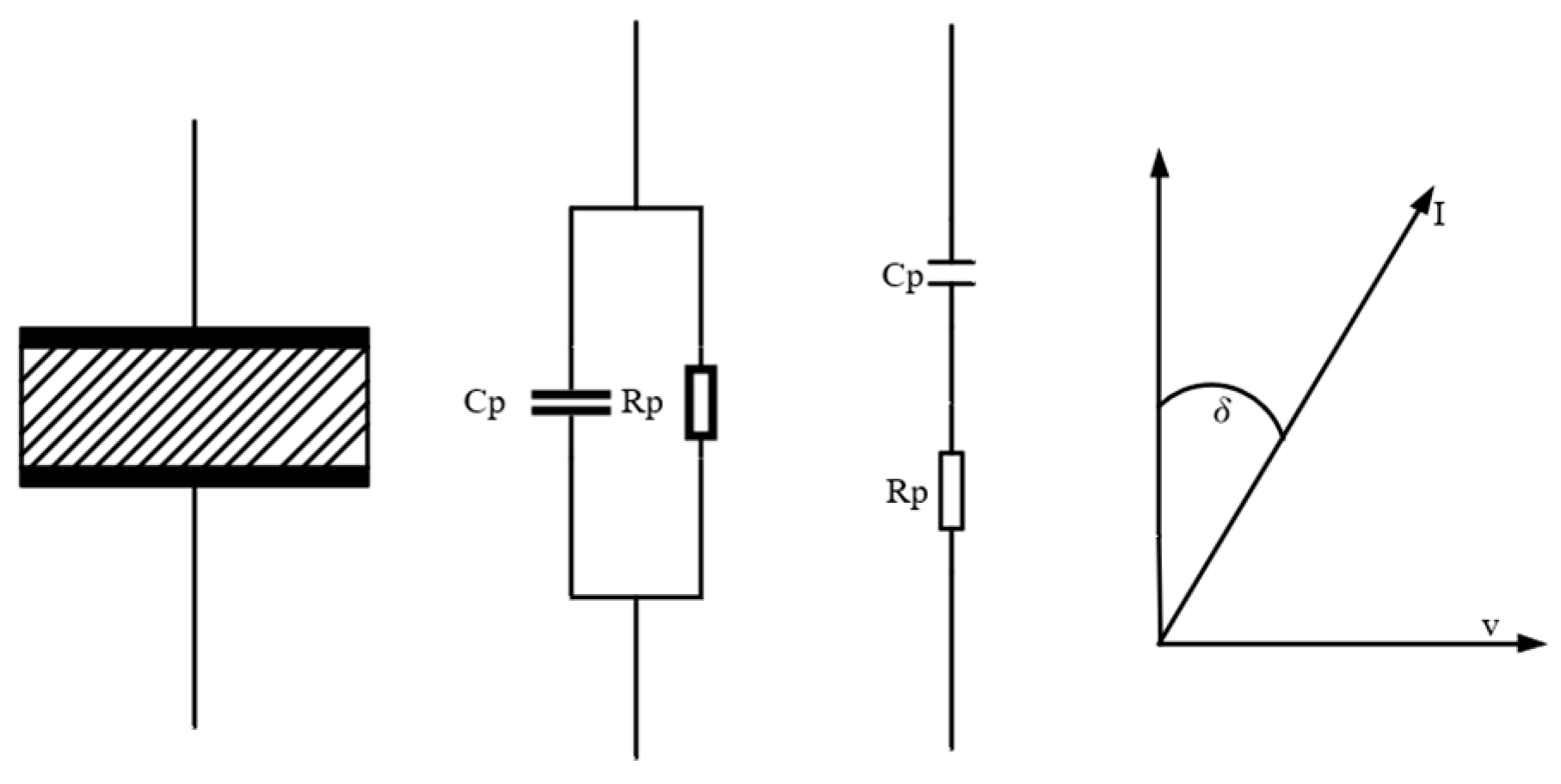
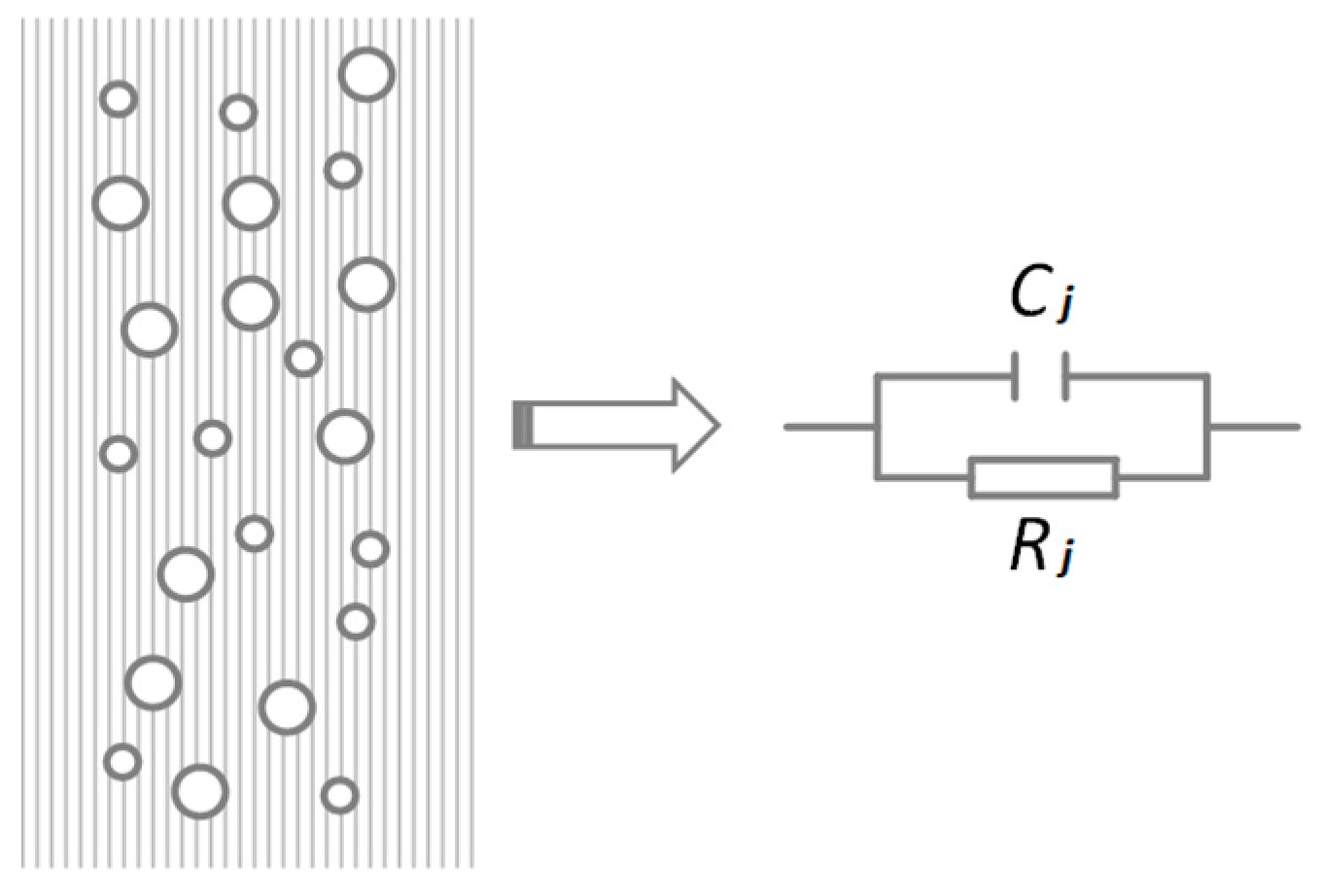
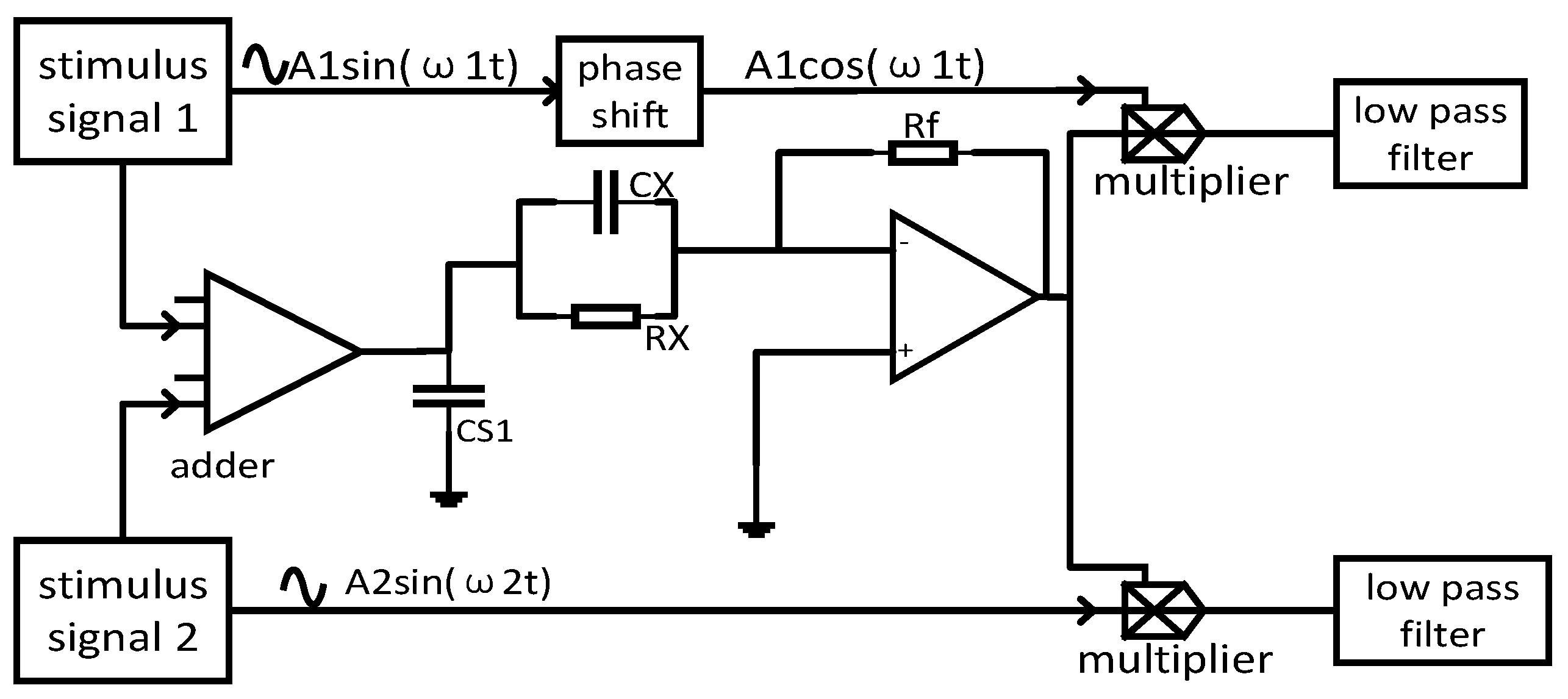
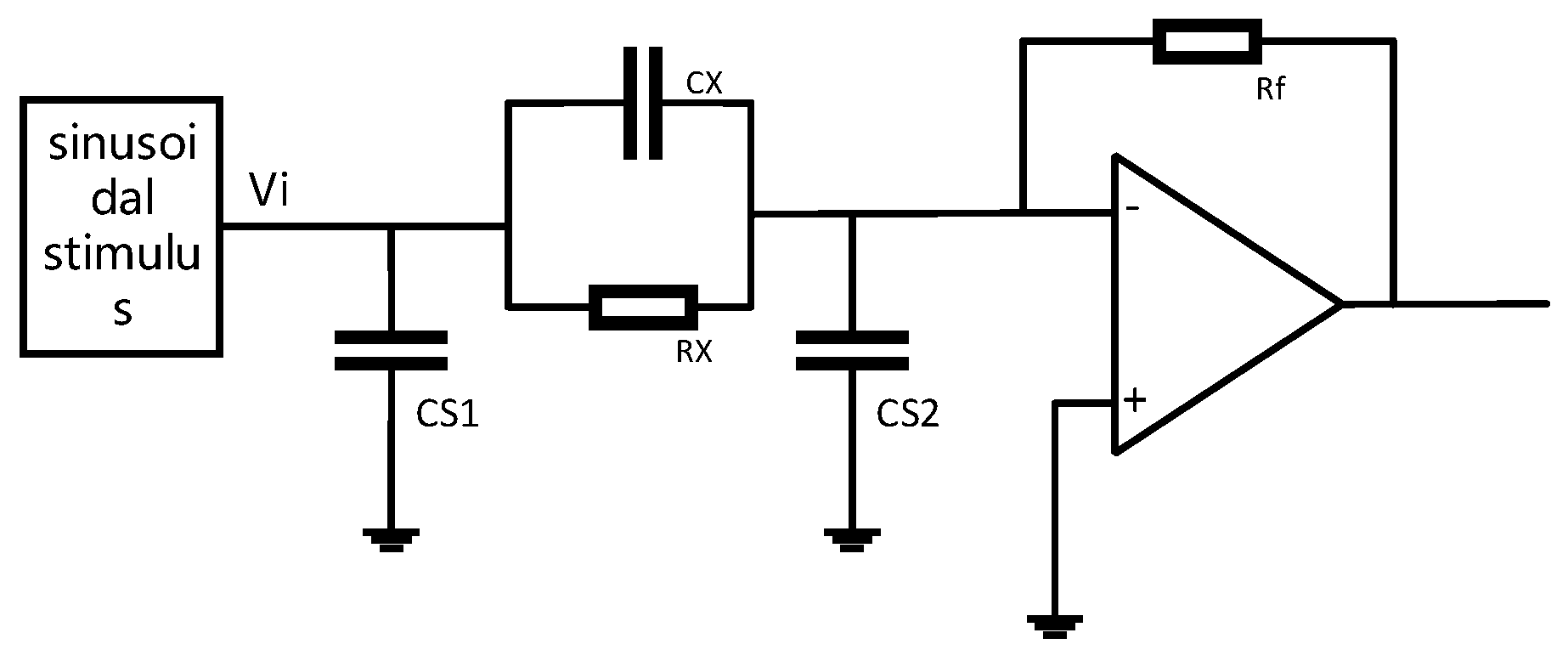


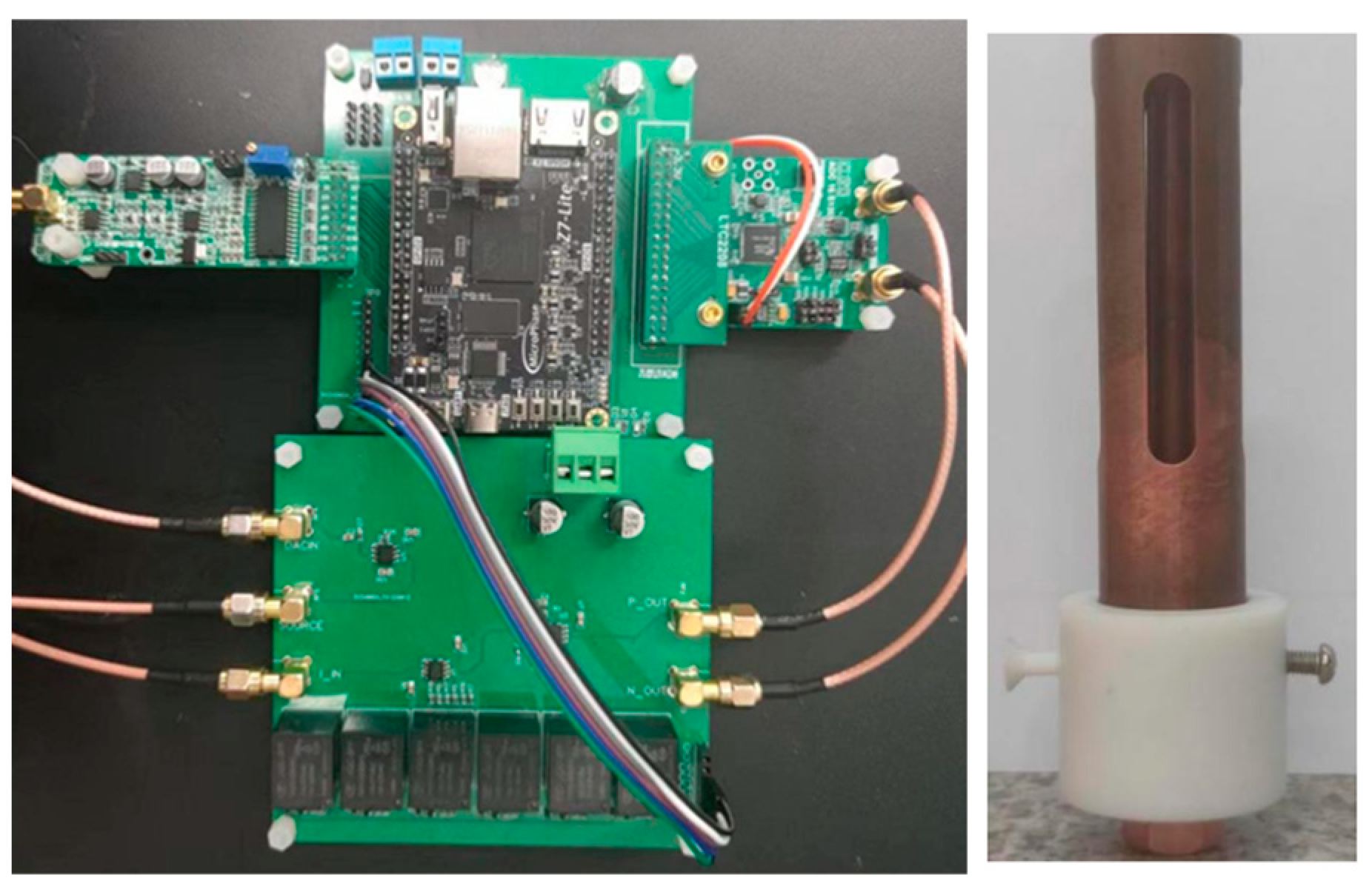

| Component Name | Model |
|---|---|
| MUC platform. | ZYNQ7100 |
| DAC chip. | AD9764 |
| ADC chip. | LTC2208 |
| Operational amplifier of resistance–capacitance measuring circuit. | AD8033 |
| Temperature sensor. | T10S-B-F |
| Measuring sensor | Coaxial cylindrical sensor with long 100 mm outer diameter 10 mm inner diameter 4 mm without insulating layer |
| File Serial Number | Feedback Resistance (Ω) | Applicable Resistance Range (Ω) | Applicable Capacitance Range (pf) |
|---|---|---|---|
| R1 | 500 | 200–1 k | 220 pF–300 pF |
| R2 | 1.5 k | 1 k–2 k | 180 pF–220 pF |
| R3 | 2.2 k | 2 k–3 k | 140 pF–180 pF |
| R4 | 3.48 k | 3 k–4.5 k | 70 pF–140 pF |
| R5 | 5 k | 4.5 k–8 k | 40 pF–70 pF |
| R6 | 10 k | 8 k–20 k | 27.5 pF–40 pF |
| Resistance and Capacitance to Be Measured | Measured Resistance Value (kΩ) | Capacitance Measured Value. (pF) | Resistance Error. (%) | Capacitance Error (%) |
|---|---|---|---|---|
| 495.3 Ω/197.3 pF | 0.536 | 182.7 | 8.2 | −5.36 |
| 1.51 kΩ/49.6 pF | 1.60 | 52.8 | 5.7 | 6.36 |
| 3.03 kΩ/22.3 pF | 3.22 | 21.3 | 6.27 | −4.28 |
| 4.98 kΩ/12.1 pF | 5.15 | 12.7 | 3.48 | 4.68 |
| 10.1 kΩ/15.3 pF | 10.6 | 16.1 | 4.74 | 5.35 |
| Resistance and Capacitance to Be Measured | Measured Resistance Value (kΩ) | Capacitance Measured Value. (pF) | Resistance Error. (%) | Capacitance Error (%) |
|---|---|---|---|---|
| 495.3 Ω/197.3 pF | 0.516 | 190.7 | 4.2 | −3.36 |
| 1.51 kΩ/49.6 pF | 1.56 | 51.4 | 3.3 | 3.72 |
| 3.03 kΩ/22.3 pF | 2.93 | 22.9 | −3.2 | 2.84 |
| 4.98 kΩ/12.1 pF | 5.12 | 12.5 | 2.72 | 3.32 |
| 10.1 kΩ/15.3 pF | 9.88 | 14.9 | −2.17 | −2.78 |
| Resistance and Capacitance to Be Measured | Measured Resistance Value (kΩ) | Capacitance Measured Value. (pF) | Resistance Error. (%) | Capacitance Error (%) |
|---|---|---|---|---|
| 495.3 Ω/197.3 pF | 0.526 | 187.0 | 6.2 | −5.26 |
| 1.51 kΩ/49.6 pF | 1.45 | 51.7 | −3.86 | 4.27 |
| 3.03 kΩ/22.3 pF | 2.90 | 27.3 | −4.18 | 2.22 |
| 4.98 kΩ/12.1 pF | 5.10 | 11.7 | 2.42 | −3.02 |
| 10.1 kΩ/15.3 pF | 10.4 | 15.9 | 3.17 | 4.22 |
| Resistance and Capacitance to Be Measured | Measured Resistance Value (kΩ) | Capacitance Measured Value. (pF) | Resistance Error. (%) | Capacitance Error (%) |
|---|---|---|---|---|
| 495.3 Ω/197.3 pF | 0.496 | 195.4 pf | 0.16 | −0.96 |
| 1.51 kΩ/49.6 pF | 1.54 | 49.2 pf | 1.98 | −0.806 |
| 3.03 kΩ/22.3 pF | 3.07 | 22.6 | 1.32 | 1.34 |
| 4.98 kΩ/12.1 pF | 4.99 | 12.3 | 0.2008 | 1.65 |
| 10.1 kΩ/15.3 pF | 10.2 | 15.6 | 0.495 | 1.96 |
| Serial Number | Conductivity Measurement (mS/m) | Conductivity Calibration Value (mS/m) | Moisture Content Measurement (%) | Moisture Calibration Value (%) | Conductivity Error (%) | moisture Content Error (%) |
|---|---|---|---|---|---|---|
| 1 | 0.98 | 0.971 | 9.4 | 9.329 | 0.912 | 0.76 |
| 2 | 1.12 | 1.07 | 10.5 | 10.45 | 4.11 | 0.48 |
| 3 | 1.26 | 1.20 | 11.6 | 11.56 | 4.99 | 0.34 |
| 4 | 1.4 | 1.33 | 12.6 | 12.6 | 4.93 | 0 |
| 5 | 1.54 | 1.48 | 13.7 | 13.63 | 3.83 | 0.51 |
| 6 | 1.68 | 1.64 | 14.3 | 14.21 | 2.08 | 0.63 |
| 7 | 1.82 | 1.82 | 15.4 | 15.34 | 0 | 0.39 |
| 8 | 1.96 | 1.98 | 16.5 | 16.58 | −1.07 | −0.48 |
| 9 | 2.1 | 2.16 | 17.5 | 17.49 | −2.86 | 0.06 |
| 10 | 2.24 | 2.28 | 18.8 | 18.62 | −1.96 | 0.96 |
| 11 | 2.38 | 2.37 | 19.9 | 19.68 | 0.46 | 1.11 |
| 12 | 2.52 | 2.47 | 20.8 | 20.72 | 2.14 | 0.38 |
| 13 | 2.66 | 2.63 | 21.6 | 21.669 | 1.28 | −0.32 |
| 14 | 2.8 | 2.82 | 22.7 | 22.72 | −0.64 | −0.09 |
| 15 | 2.94 | 2.98 | 23.5 | 23.38 | −1.19 | 0.51 |
| 16 | 3.08 | 3.09 | 25.1 | 24.87 | −0.19 | 0.92 |
| 17 | 3.22 | 3.21 | 26.2 | 26.09 | 0.37 | 0.42 |
| 18 | 3.36 | 3.36 | 27.3 | 27.19 | −0.09 | 0.4 |
| 19 | 3.5 | 3.51 | 28.6 | 28.53 | −0.31 | 0.24 |
| 20 | 3.64 | 3.62 | 29.8 | 29.72 | 0.44 | 0.27 |
| 21 | 3.78 | 3.74 | 30.9 | 30.81 | 1.14 | 0.29 |
| Physical Property Parameters to Be Measured | Measure Moisture Content (%) | Measure Conductivity (ms/m) | Moisture Content Error (%) | Conductivity Error (%) |
|---|---|---|---|---|
| 40.1%/4 ms/m | 40.15 | 4.1 | 0.12 | 2.5 |
| 20.6%/2.6 ms/m | 20.68 | 2.7 | 0.38 | 3.8 |
| 10.3%/2 ms/m | 10.41 | 2.08 | 1.05 | 4 |
| 9.5%/1.8 ms/m | 9.59 | 1.76 | 0.94 | 2.22 |
| 4.7%/0.95 ms/m | 4.72 | 0.91 | 0.42 | 4.2 |
Disclaimer/Publisher’s Note: The statements, opinions and data contained in all publications are solely those of the individual author(s) and contributor(s) and not of MDPI and/or the editor(s). MDPI and/or the editor(s) disclaim responsibility for any injury to people or property resulting from any ideas, methods, instructions or products referred to in the content. |
© 2023 by the authors. Licensee MDPI, Basel, Switzerland. This article is an open access article distributed under the terms and conditions of the Creative Commons Attribution (CC BY) license (https://creativecommons.org/licenses/by/4.0/).
Share and Cite
Song, C.; Yao, C.; Liu, Q.; Sun, W.; Zhang, H. Measurement Method of Physical Parameters of Two-Phase Flow Based on Dual-Frequency Demodulation. Sensors 2023, 23, 9354. https://doi.org/10.3390/s23239354
Song C, Yao C, Liu Q, Sun W, Zhang H. Measurement Method of Physical Parameters of Two-Phase Flow Based on Dual-Frequency Demodulation. Sensors. 2023; 23(23):9354. https://doi.org/10.3390/s23239354
Chicago/Turabian StyleSong, Chunhui, Chengzhi Yao, Qinghong Liu, Wenyu Sun, and Hui Zhang. 2023. "Measurement Method of Physical Parameters of Two-Phase Flow Based on Dual-Frequency Demodulation" Sensors 23, no. 23: 9354. https://doi.org/10.3390/s23239354
APA StyleSong, C., Yao, C., Liu, Q., Sun, W., & Zhang, H. (2023). Measurement Method of Physical Parameters of Two-Phase Flow Based on Dual-Frequency Demodulation. Sensors, 23(23), 9354. https://doi.org/10.3390/s23239354





